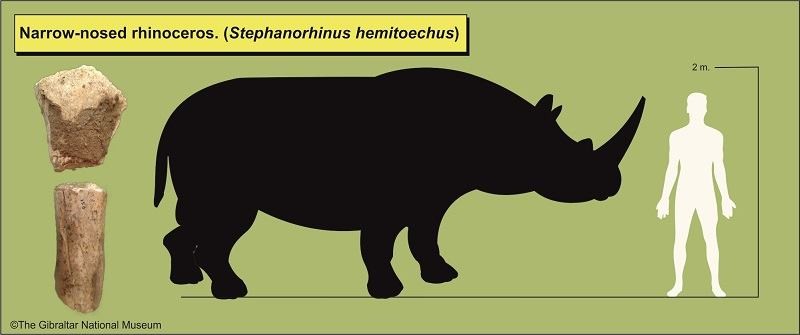Narrow-nosed rhinoceros (Stephanorhinus hemitoechus)
Narrow-nosed rhinoceros (Stephanorhinus hemitoechus)
Today we bring you the bone fragments from the radius of a narrow-nosed rhinoceros found at Gorham’s Cave. This large mammal once inhabited the Eurasian continent. It was an imposing animal, reaching a height of two metres. It appeared in Europe 600,000 years ago, becoming extinct around 40,000 years ago, being replaced by woolly rhinos in the colder regions of Europe.
Due to its large size and its potential to inflict injuries, it was not one of the main prey of the Neanderthals, although there is evidence that they were eaten. This has been proven by both cut marks on skeletal remains as well as by analysing isotopes in Neanderthal bones from different sites across Central Europe.
Surrounding the caves of Gibraltar, was a landscape which has since disappeared due to rising sea levels. It was in this, now submerged, landscape where this animal found a suitable habitat – a temperate Mediterranean savannah where it would feed on grasses and leaves.
This species was described in 1859 by Hugh Falconer, a Scottish geologist considered the father of palaeontology. Falconer had a close relationship with Gibraltar, having visited several caves on the Rock. He also proposed the name of ‘Homo calpicus’, to George Busk, for the Neanderthal skull discovered at Forbes’ Quarry in 1848. Busk’s cautious nature made him refrain from giving it that binomial name.

Published: May 02, 2020
Other similar VM - Paleontology
VM - Paleontology
palaeontology rosia bay and the beginnings of life and earth sciences
Published: April 06, 2020
Virtual Museum VM - Paleontology
A metapodial fragment belonging to an Aurochs
Published: June 28, 2020
18-20 Bomb House Lane
PO Box 939,
Gibraltar
